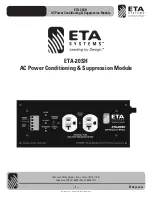
7
6
Servicing/Return to AudioQuest
Servicing of the Niagara 1000 must be performed by AudioQuest, and is only required
when:
¡
The Niagara 1000 has been exposed to rain, flooding, or extreme moisture
¡
The Niagara 1000 does not appear to operate normally (See “Trouble-Shooting Guide ”)
¡
The Niagara 1000 has been dropped and sustained considerable physical damage
If sending the Niagara 1000 to AudioQuest for servicing (or shipping it for any reason),
please use the factory approved packaging materials If you have lost any of these
(corrugated carton, two foam inserts, one poly bag), please contact AudioQuest for
replacements or advice We will provide replacement packaging materials for a nominal
charge; shipping costs will be paid by the individual or company requesting the
packaging material Please do not rely on other methods of packaging, including those
provided or suggested by packaging/mailing stores These methods and materials
could seriously damage the product, as well as its finish Even the loss of the polybag
is enough to permanently damage the finish during transport If you have lost the
original packaging material, please request replacement materials from AudioQuest or
consult us for appropriate options
Power Source
Ideally, the power source to which the Niagara 1000 is connected should be adequate
for use at 120V single-phase nominal voltage, 15 amps (current capacity RMS) However,
the Niagara 1000 will operate very well with a 20-amp service outlet
For proper operation, the Niagara 1000 requires a safety ground (supplied via the
power utility AC wall outlet)
Placement
The Niagara 1000 is manufactured with four rubber feet for safe, secure placement
on any table, cabinet, shelf, or floor The Niagara 1000’s design obviates the need for
compliant or high-Q isolation feet Although many audio/video products benefit
greatly from these devices, the Niagara 1000 does not
Placement or proximity to other components is not critical, and, under standard use,
the Niagara 1000 does not produce any heat
Connection to Audio/Video Components
AC Cable Routing
Once the Niagara 1000 is placed, an appropriate 15-amp-rated AC cord must be
connected to the AC inlet (IEC-C14) connector The AC cord must have an IEC-C13
female end connector and a grounded male 120VAC Edison/NEMA plug for use in North
America or Taiwan We highly endorse the use of any AudioQuest NRG Series 15-amp-
rated AC cord, but the Niagara 1000 will function properly with any appropriate AC
cord that meets the aforementioned requirements
Whenever possible, it is best to keep at least three inches (approximately 7cm) between
AC cables and any signal cable When this is not possible in a practical layout of system
cabling, crossing the AC cables to signal cables at 90 degrees is best to minimize
induced noise

































